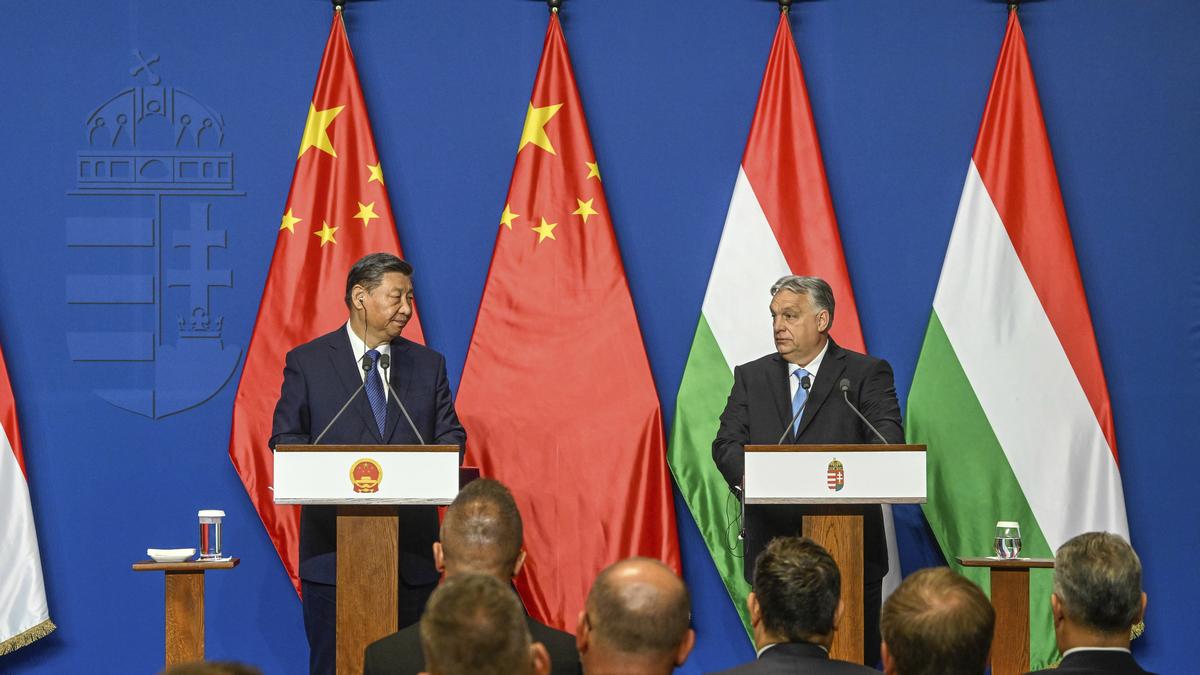‘Hungary is today the closest ally of China within the EU’
| Photo Credit: AP
The Chinese President Xi Jinping’s first trip to Europe (except Russia) in five years, earlier this month, was carefully constructed as evidenced by his ports of call — France, Serbia and Hungary. The first is a leading proponent of the notion of “strategic autonomy” of Europe, the second is a non-North Atlantic Treaty Organization, non-European Union (EU) outlier close to Russia, and the third is a pro-Russian maverick that has blocked many resolutions criticising China in EU.
World events, visit’s goals
The COVID-19 pandemic had the effect of closing off China to the rest of the world for an extended period, forcing Beijing to re-adjust its global investment goals because of economic problems. Indeed, Mr. Xi did not travel abroad for two and a half years and has not been too frequent a traveller even after the restrictions were lifted last year.
In this period, the world had been turned upside down geopolitically by the Russian invasion of Ukraine. In the meantime, the China-United States trade war has morphed into a technology war and the Biden administration has broadened and intensified the technology restriction regime on China. In the U.S. and Europe, accusations of Chinese dumping of cheap goods have intensified and there are calls for retaliation. A lot of them focus on electric vehicles (EV), an area where China has emerged a world leader.
Mr. Xi had three goals — to prevent the EU from getting too close to the U.S., to avert a trade standoff with EU and to bolster China’s standing in Europe. He has had to do all this in the face of the fallout of the Russian invasion of Ukraine that has hardened the western alliance against Russia, with China having to sustain some collateral damage. It has also had an indirect influence in shaping negative EU views on China’s trade policy.
The goals of French President Emmanuel Macron were fairly straightforward — to promote French trade interests as well as to push China to stop supplying weapons components to Moscow. He did his own messaging by meeting the Tibetan Sikyong (Prime Minister of the government in exile) Penpa Tsering on the eve of the Xi visit.
In Paris, Mr. Xi also met with the European Commission President Ursula von der Leyen who has advocated a policy of “de-risking” from China by reducing dependence on Chinese imports and technology. Both Mr. Macron and the EU chief urged China to ensure a more balanced trade with Europe.
France is united with the EU on the issue of the cost advantage that Chinese EVs have over European cars. While the Chinese are keen to ride on the strength of their EV industry, the Europeans are equally keen to protect their car manufacturers.
In 2019, the EU had recast its doctrine to define China as “a partner for cooperation, an economic competitor and a systemic rival.” A sceptical Chinese Foreign Minister Wang Yi has described it as driving to a crossing where the lights are simultaneously green, yellow and red. But this somewhat convoluted formulation seeks to balance Europe’s China policy between the economic opportunity it sees there, with the risks from China’s economic policy and its national security postures.
The focus on Hungary
Mr. Xi got a warm welcome in Serbia and Hungary which do not otherwise attract top-drawer visitors. Chinese foreign direct investment in Serbia is growing and it has invested $5.5 billion in the country, mainly in copper mining and a steel processing plant. The big investment common to both countries has been in the upgradation of the Belgrade-Budapest high-speed railway project, and there are plans for more roads, tunnels and bridges with Chinese investment. Newer plans exist for railways to link Chinese factories in eastern Hungary to markets in western Europe. CATL, the giant Chinese battery company, is setting up a plant to supply German EV makers. The Chinese EV giant, BYD, which hopes to capture the European market, has chosen the southern Hungarian city Szeged to set up its first factory in Europe.
Hungary is today the closest ally of China within the EU and it provides China access to the world’s largest trading bloc. Its world view is at odds with its Eastern European neighbours who are wary of Russian aggressiveness, and by extension, China.
Between eastern and western Europe
China had sought to develop ties with eastern European countries through the so-called 17+1 China and Eastern Europe (CEE) community to serve as a gateway for markets in rich western Europe. However, this has now fallen victim to the Ukraine war which has strained ties between China and many of the Eastern European countries which are backing Ukraine. In all fairness the CEE had begun to pall even before the invasion of Ukraine as the countries realised that despite promises, the Chinese remained focused on western Europe.
Europe itself figures large in Beijing’s world view. Among the key Belt and Road Initiative (BRI) projects have been railways linking China to Europe via Central Asia. With the help of high-speed trains, the Chinese aim is to crunch the overland distance between themselves and prosperous Europe, which they see as a market for their increasingly sophisticated products.
Given the global developments, Mr. Xi’s visit can be seen as a defensive one, aimed at preserving Chinese interests in Europe in the face of adverse geopolitics. But visits to Hungary and Serbia, though high on the friendship front, are not likely to break much ice with the rest of Europe which is increasingly sceptical of China.
Manoj Joshi is Distinguished Fellow, Observer Research Foundation, New Delhi

